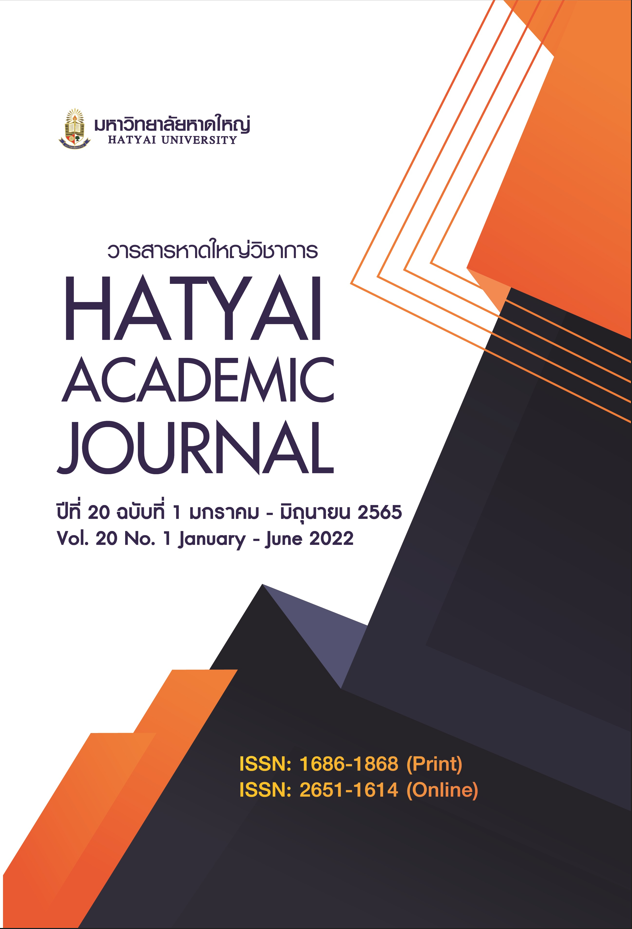โมเดลความสัมพันธ์ระหว่างภาวะผู้นำเชิงกลยุทธ์ การจัดการนวัตกรรม กับผลการดำเนินงานของมหาวิทยาลัยเอกชนในประเทศไทย
Main Article Content
บทคัดย่อ
การวิจัยครั้งนี้มีวัตถุประสงค์เพื่อศึกษาโมเดลความสัมพันธ์เชิงสาเหตุของภาวะผู้นำเชิงกลยุทธ์ การจัดการนวัตกรรม กับผลการดำเนินงานของมหาวิทยาลัยเอกชนในประเทศไทย กรอบแนวคิดการวิจัยครั้งนี้สังเคราะห์จากผลการดำเนินงานขององค์กร ร่วมกับภาวะผู้นำเชิงกลยุทธ์ และการจัดการนวัตกรรม ใช้ระเบียบวิธีวิจัยเชิงพรรณนาเพื่อหาความสัมพันธ์ กลุ่มตัวอย่าง คือ ผู้บริหารมหาวิทยาลัยเอกชนในประเทศไทย จำนวน 358 คน ใช้วิธีสุ่มตัวอย่างแบบง่าย เครื่องมือที่ใช้ในการวิจัย คือ แบบสอบถามมาตราส่วนประมาณค่า 5 ระดับ ค่าความเชื่อมั่นของแบบสอบถามการวิจัยแสดงด้วยค่าสัมประสิทธิ์แอลฟาของครอนบาคเท่ากับ 0.91 สถิติที่ใช้ในการวิเคราะห์ข้อมูลประกอบด้วย ค่าความถี่ ค่าร้อยละ ค่าเฉลี่ย ส่วนเบี่ยงเบนมาตรฐาน ทำการการวิเคราะห์โมเดลสมการโครงสร้างโดยการวิเคราะห์เส้นทาง
ผลการวิจัยพบว่า โมเดลความสัมพันธ์ระหว่างภาวะผู้นำเชิงกลยุทธ์ การจัดการนวัตกรรม และผลการดำเนินงานของมหาวิทยาลัยเอกชนในประเทศไทยมีความสอดคล้องกับข้อมูลเชิงประจักษ์ (= 308.38, df = 259, p-value = 0.19,
/df = 1.19, GFI = 0.94, AGFI = 0.92, RMSEA = 0.02, RMR = 0.01, CFI = 0.99) ซึ่งภาวะผู้นำเชิงกลยุทธ์มีอิทธิพลทางตรงต่อการจัดการนวัตกรรม (
= 0.77, p-value < 0.05) และมีอิทธิพลทางตรงต่อผลการดำเนินงานของมหาวิทยาลัยเอกชน (
= 0.51, p-value < 0.05) การจัดการนวัตกรรมมีอิทธิพลทางตรงต่อผลการดำเนินงานของมหาวิทยาลัยเอกชน (
= 0.43, p-value < 0.05) และภาวะผู้นำเชิงกลยุทธ์มีอิทธิพลทางอ้อมต่อผลการดำเนินงานของมหาวิทยาลัยเอกชนโดยผ่านการจัดการนวัตกรรม (
= 0.84, p-value < 0.05) จากผลการวิจัยชี้ให้เห็นว่าภาวะผู้นำเชิงกลยุทธ์และการจัดการนวัตกรรมมีความสำคัญต่อผลการดำเนินงานของมหาวิทยาลัย ดังนั้น จึงควรมีการพัฒนาผู้บริหารให้มีภาวะผู้นำเชิงกลยุทธ์ และมีการนำเข้า สร้าง และพัฒนานวัตกรรม เพื่อการบริหารหลักสูตรและการจัด
การเรียนการสอนที่จะนำไปสู่การปฏิบัติงานของมหาวิทยาลัยที่มีประสิทธิผลสูงขึ้น
Article Details

This work is licensed under a Creative Commons Attribution-NonCommercial-NoDerivatives 4.0 International License.
ทุกบทความที่ได้รับการตีพิมพ์ ผ่านการประเมินจากผู้ทรงคุณวุฒิ (Peer Review) จำนวน 3 ท่าน จากหลากหลายสถาบัน โดยผู้ประเมินบทความไม่ทราบชื่อผู้เขียน และผู้เขียนไม่ทราบชื่อผู้ประเมิน (Double-blind Review) ข้อความและบทความในวารสารหาดใหญ่วิชาการเป็นแนวคิดของผู้เขียน มิใช่ความคิดเห็นของคณะผู้จัดทำ และมิใช่ความรับผิดชอบของมหาวิทยาลัยหาดใหญ่ กองบรรณาธิการวารสารหาดใหญ่วิชาการ ไม่สงวนสิทธิ์การคัดลอกบทความเพื่อใช้ประโยชน์ทางวิชาการ แต่ให้อ้างอิงแสดงที่มาของบทความ
References
Adair, J. (2010). Strategic Leadership: How to think and plan strategically and provide direction. London: Pan Macmillan.
Al-Husseini, S. J. H. (2014). The impact of leadership style on innovation in Iraq’s Higher Education Institutions: The role of knowledge sharing (Doctoral dissertation). Plymouth University, Plymouth, UK.
Boal, K. B., & Schultz, P. L. (2007). Storytelling, time, and evolution: The role of strategic leadership in complex adaptive systems. The Leadership Quarterly, 18(4), 411-428.
Boonrat, A. (2014). The roadmap for developing image of private universities in Thailand. (Doctoral dissertation). Prince of Songkla University, Songkhla. [in Thai]
Chatbenjanun, J. (2015). Causal relationship model of the factors affecting trait strategic leadership of administrators under primary educational service area office. (Doctoral dissertation). Valay Alongkorn Rajabhat University under the Royal Patronage, Pathum Thani. [in Thai]
Hooper, D., Coughlan, J., & Mullen, R. M. (2008). Structural equation modeling: Guidelines for determining model fit. Electronic Journal on Business Research Methods, 6(1), 53-60.
Khienchananaj, T., & Smarnyad, S. (2017). Causal factors affecting the effectiveness of Private Higher Education Institutions. Journal Social Science, MCU, 6(2), 227-240. [in Thai]
Kitonga, D. M. (2017). Strategic leadership practices and organizational performance in not-for-profit organizations in Nairobi county in Kenya (Doctoral dissertation). Jomo Kenyatta University of Agriculture and Technology, Nairobi.
Maziti, L., Chinyamurindi, W., & Marange, C. (2018). The relationship between strategic leadership, innovation performance and competitive advantage amongst a sample of small businesses in South Africa. Journal of Contemporary Management, 15(1), 368-394.
Miller, B. A. (2007). Assessing organizational performance in Higher Education. San Francisco: John Wiley & Sons.
Ministry of Higher Education, Science, Research and Innovation. (2019). Policy and strategy for higher education, science, research and innovation 2020-2027 and science, research and innovation plan. Retrieved from https://www.mhesi.go.th/home/ index.php/aboutus/stg-policy/930-2563-2570 [in Thai]
Namtip, S., & Khongmalai, O. (2015). The impact of service innovation to competitive advantage in higher education. SDU Research Journal Humanities and Social Science, 11(2), 42-59. [in Thai]
National Statistical Office of Thailand. (2019). Summary of the survey of working conditions of the population in February 2019. Retrieved from http://www.nso.go.th/sites/2014/ DocLib13/ด้านสังคม/สาขาแรงงาน/ภาวะการทำงานของประชากร/2562/Report_02-62.pdf [in Thai]
Office of the Higher Education Commission. (2017). The situation of graduates are employed. Retrieved from http://www.employ.mua.go.th/ [in Thai]
Office of the Ministry of Higher Education, Science, Research and Innovation. (2018). Higher education statistics. Retrieved from http://www.info.mua.go.th/information/show_all_statdata_table.php?data_show=2 [in Thai]
Polit, D. F., & Beck, C. T. (2008). Nursing research: Generating and assign evidence for nursing practice (8th ed.). Philadelphia: Lippincott.
Polsarum, P. (2019, July 25). Deputy dean of Faculty of Education, Chulalongkorn University. (interview) [in Thai]
Ramlall, S. (2012). Human resource management in Saudi Arabia. International Business & Economics Research Journal, 11(10), 1155-1159.
Sakrungpongsakul, S. (2019, August 16). Dean of Faculty of Business Administration, Panyapiwat Institute of Management. (interview) [in Thai]
Sansuk, J. (2014). Antecedents and consequence of strategic leadership capabilities of Higher Education Institute in Thailand. Journal of the Association of Researchers, 19(1), 34-46. [in Thai]
Shisia, A., Sang, W., Matoke, J., & Omwario, B. N. (2014). Strategic innovation and performance of public universities in Kenya. European Journal of Business and Management, 6(23), 2222-2839.
Songkramsri, S., U-on, V., & Teerathanachaiyakun, K. (2016). Relationship model of strategic leadership effectiveness human resource management and performance of Thai Vocational Education Institute. Suranaree Journal, 10(1), 41-64. [in Thai]
Srisa-an, C. (2019, July 30). Dean of College of Digital Innovation and Information Technology, Rangsit University. (interview) [in Thai]
Tavisapakit, P. (2015). The influence of leadership identity, knowledge management, technology and innovation management on the performance of listed companies in the market for alternative investment of Thailand (Doctoral dissertation). Ramkhamhaeng University, Bangkok. [in Thai]
Tidd, J., & Bessant, J. (2014). Management innovation (5th ed.). West Sussex: Wiley.
Walker, R. M., Damanpour, F., & Devece, C. A. (2010). Management innovation and organizational performance: The mediating effect of performance management. Journal of Public Administration Research and Theory, 21(1), 367-386.
Yamane, T. (1973). Taro statistic : An introductory analysis. New York: Harper & Row.
Yongsorn, C. (2017). Educational waste affects the quality of graduates of Thai higher education. Journal of Education: Faculty of Education, Srinakharinwirot University, 18(1), 1-9. [in Thai]
Yusuf, R. M., Hamzah, M. G., & Tikson, S. D. (2017). Strategic leadership, good governance: Analysis and the effect to performance. Advances in Economics, Business and Management Research, 40(1), 214-218.
